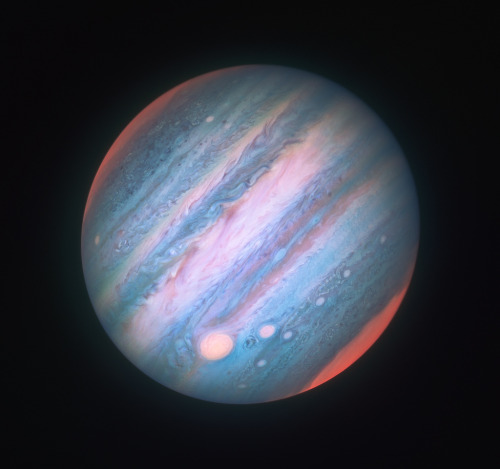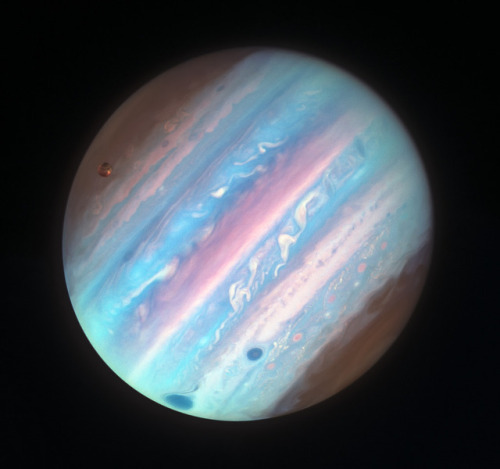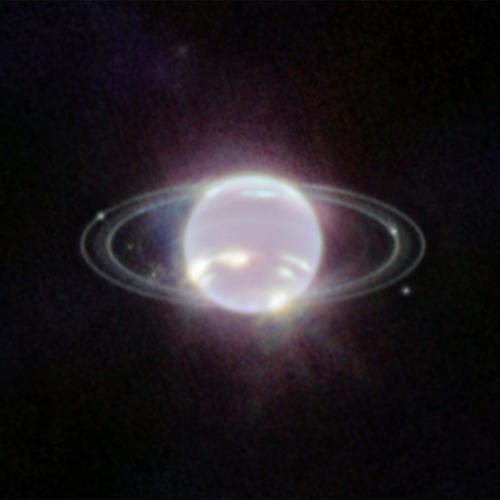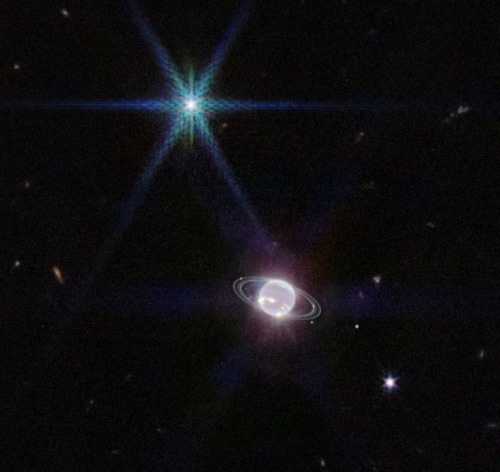“The Shockwave From A 20,000 Year-old Supernova Explosion In The Constellation Of Cygnus Is Still Expanding

“The shockwave from a 20,000 year-old supernova explosion in the constellation of Cygnus is still expanding into interstellar space. The collision of this fast moving wall of gas with a stationary cloud has heated it causing it to glow in visible as well as high energy radiation, producing the nebula known as the Cygnus Loop (NGC 6960/95). The nebula is located a mere 1,400 light-years away. The colors used here indicate emission from different kinds of atoms excited by the shock: oxygen-blue, sulfur-red, and hydrogen-green. This picture was taken with the Wide Field and Planetary Camera 2 on board the Hubble Space Telescope.”
Photo by J Hester of ASU, description via NASA.
More Posts from Night-hides-the-world and Others


Jupiter in Near-Infrared Jupiter and Ganymede in Near-UV and Blue
by Judy Schmidt
More than Just Dust in the Wind

From space, we can see a swirling brown mass making its way across the Atlantic – dust from the Sahara Desert – the largest hot desert in the world. It’s a normal phenomenon. Every year, winds carry millions of tons of dust from North Africa, usually during spring and summer in the Northern Hemisphere.

June 2020 has seen a massive plume of dust crossing the ocean. It’s so large it’s visible from one million miles away in space.

Dust clouds this large can affect air quality in regions where the dust arrives. The particles can also scatter the Sun’s light, making sunrises and sunsets more vibrant.

Dust particles in the air are also known as aerosols. We can measure aerosols, including dust, sea salt and smoke, from satellites and also use computer models to study how they move with the wind.

Following the transport of dust from space shows us how one of the driest places on Earth plays a role in fertilizing the Amazon rainforest. There are minerals in Saharan dust, like phosphorous, that exist in commercial fertilizers, helping seed the rainforest.

Make sure to follow us on Tumblr for your regular dose of space: http://nasa.tumblr.com


NASA released the clearest images of Neptune’s rings in over 30 years.

This is a snip of The Sharpest View Ever of the Andromeda Galaxy.
You need to go to the cite to experience it.
Source: NASA, ESA, J. Dalcanton (University of Washington, USA), B. F. Williams (University of Washington, USA), L. C. Johnson (University of Washington, USA), the PHAT team, and R. Gendler.
Candy Cane of Cosmic Proportions
Imagine how long it would take to eat a candy cane that’s a thousand trillion miles tall! 😋

Scientists peering into the center of our Milky Way galaxy found this 190-light-year tall “candy cane,” but (sadly) it is not a peppermint treat. It does contain other goodies, though. They have found huge collections of material, called giant molecular clouds, where stars are being born. And there are magnetic fields that might be evidence of a bubble from an outburst in our galactic center long ago.

The full image shows our galaxy’s center in infrared (blue), radio (red) and microwave (“minty” green) light. The picture essentially color codes different ways light is produced. The blue and cyan regions show us cool dust where star formation has just begun. Yellow features show more-established star “factories.” Red reveals places where electrically charged gas interacts with magnetic fields.
This image includes newly published observations using an instrument designed and built at NASA’s Goddard Space Flight Center in Greenbelt, Maryland, called the Goddard-IRAM Superconducting 2-Millimeter Observer (GISMO). It was used with a 30-meter radio telescope located on Pico Veleta, Spain, operated by the Institute for Radio Astronomy in the Millimeter Range headquartered in Grenoble, France. The image shows a region about 750 light-years wide.
Find out more about this image and what we can learn from studying star factories!
Make sure to follow us on Tumblr for your regular dose of space: http://nasa.tumblr.com




As promised, here is a comic about the brightest star in the northern Hemisphere: Sirius! Sirius B will be shown in future comics as 2018 is year of the dog and since Sirius is the dog star, it is year of the Sirius!
Enjoy!
https://www.space.com/21702-sirius-brightest-star.html

shit man this got me emotional
-
 night-hides-the-world reblogged this · 10 years ago
night-hides-the-world reblogged this · 10 years ago -
 skiesandclusters reblogged this · 10 years ago
skiesandclusters reblogged this · 10 years ago
Astronomy and the other wonders you witness when you look to the skies.
115 posts



